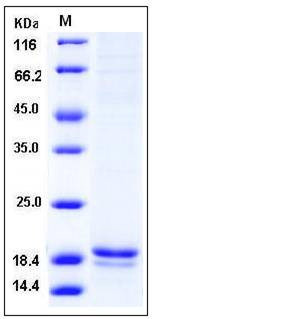Human ALOX5AP / FLAP Protein (His Tag)
FLAP
- 100ug (NPP1890) Please inquiry
| Catalog Number | P11623-H08B |
|---|---|
| Organism Species | Human |
| Host | Baculovirus-Insect Cells |
| Synonyms | FLAP |
| Molecular Weight | The recombinant human ALOX5AP consists of 167 amino acids and predicts a molecular mass of 19 kDa as estimated in SDS-PAGE under reducing conditions. |
| predicted N | Met 1 |
| SDS-PAGE |  |
| Purity | > 90 % as determined by SDS-PAGE |
| Protein Construction | A DNA sequence encoding the full length of human ALOX5AP (NP_001620.2) (Met 1-Pro 161) was fused with a polyhistidine tag at the carboxy-terminus. |
| Bio-activity | |
| Research Area | Cardiovascular |Cardiovascular disease Therapeutic Targets |Coronary Artery Disease Therapeutic Targets |
| Formulation | Lyophilized from sterile 20mM Tris, 150mM NaCl, 10% gly, pH 7.4, 0.5% triton, 5mM DTT 1. Normally 5 % - 8 % trehalose, mannitol and 0.01% Tween80 are added as protectants before lyophilization. Specific concentrations are included in the hardcopy of COA. |
| Background | Arachidonate 5-Lipoxygenase-Activating Protein (ALOX5AP), also known as FLAP, belongs to the MAPEG family. ALOX5AP/FLAP is an essential partner of 5-LO for this process. The FLAP (ALOX5AP) gene has been linked to risk for myocardial infarction, stroke and restenosis, reigniting pharmaceutical interest in this target. It had been found that ALOX5AP/FLAP is a key enzyme in leukotriene formation, in both human pulmonary microvascular endothelial cells and a transformed human brain endothelial cell line. In addition, the protein FLAP has recently been identified as an emerging target in metabolic disease. In fact, FLAP is overexpressed in the adipose tissue of patients and experimental animals with obesity. |
| Reference |
